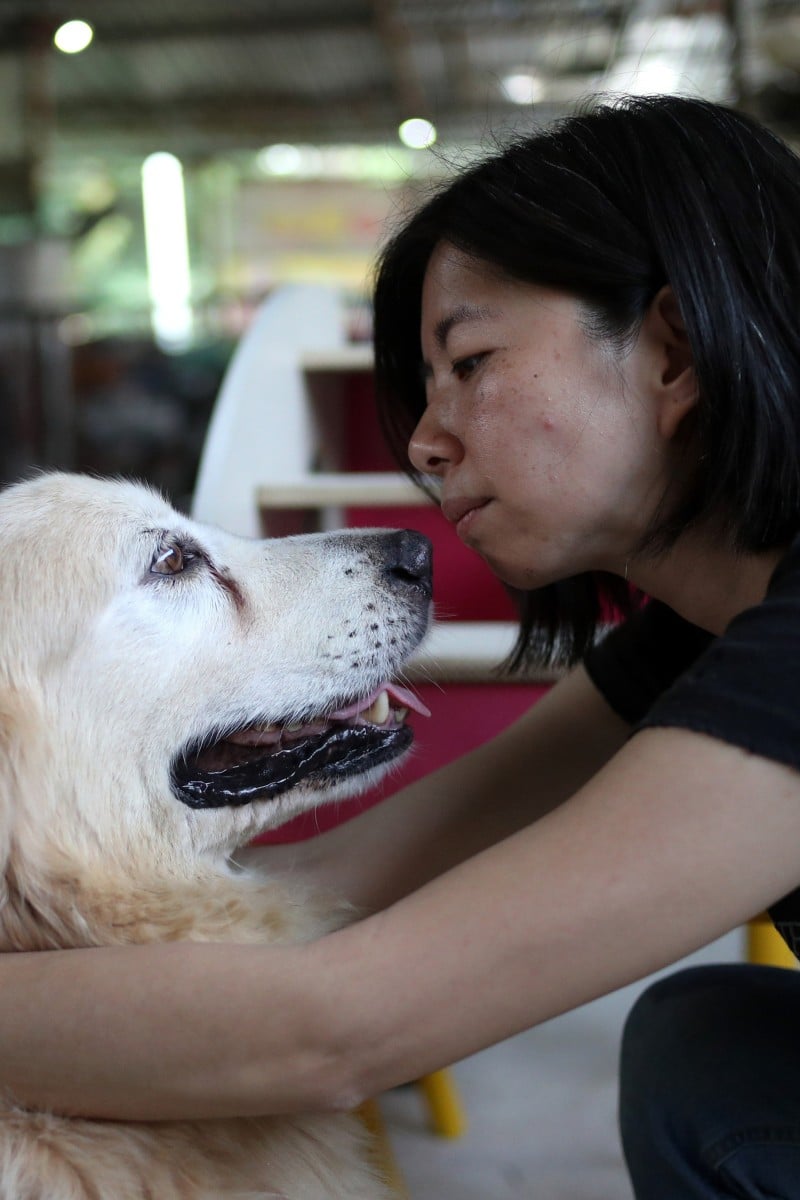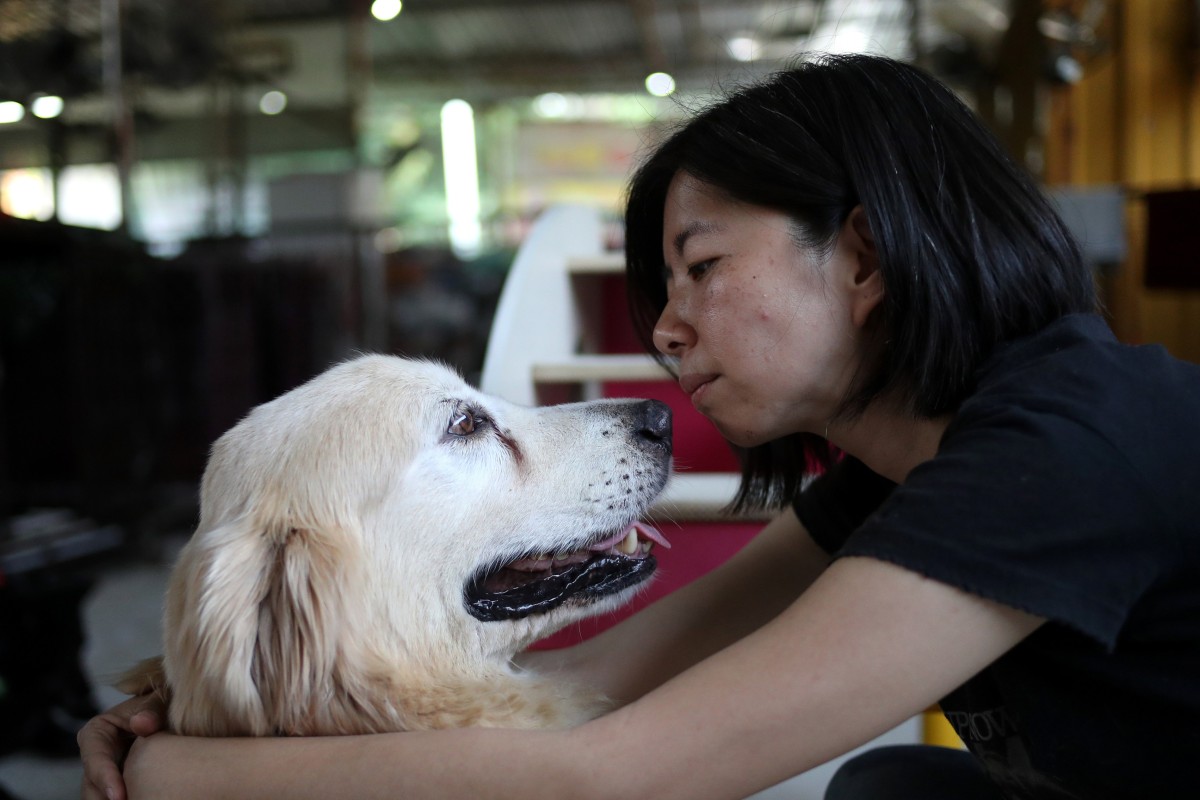
‘Woof’ under one roof: House of Joy and Mercy shelters dogs abandoned as owners leave villages under development plan
- Founder of animal shelter in Yuen Long discusses the struggles of caring for the dogs left behind as their families could not take them to the flats they moved to
- NGO has many canines in need of a home, but they are not getting adopted because they are bigger and from breeds less popular with Hong Kong people
 Ivy Tse is the founder of House of Joy and Mercy, which has two animal shelters in Yuen Long. Photo: Winson Wong
Ivy Tse is the founder of House of Joy and Mercy, which has two animal shelters in Yuen Long. Photo: Winson WongIvy Tse Yuen-yee, the founder of an animal shelter, still remembers picking up two mongrels, Wong Wong and Pearl, from their owners’ homes two years ago.
The dogs originally belonged to a family who lived in a village in the New Territories. But under government development plans, this family – along with other villagers in the area – was forced to abandon their home.
Wong Wong and Pearl’s owners moved to a flat in a building where they could not bring their beloved pets.
Tse took the dogs to House of Joy and Mercy, the foster home for stray animals that she founded in 2015. The two were cautious at first but eventually let their guards down.
‘Paw-ga’ sessions teach yoga with shelter dogs
“Whenever their owners came to visit them, the dogs still remembered their owners and welcomed them happily,” Tse recalled, adding that the owners cried every time they said goodbye.
But after a few visits, they never returned.
“They felt that it was too painful to visit and leave with such sorrow. It felt heart-wrenching to see this; it’s like they were forced to separate,” Tse lamented.
Wong Wong and Pearl are only two of the many victims of the city’s development.
Tse explained that ever since the North East New Territories New Development Areas Planning in Hong Kong was put into action in 2018, the scheme moved from one area to the next, relocating villagers and their pets.
The Agriculture, Fisheries and Conservation Department (AFCD) said they “received 90 dogs from residents in the New Development Areas” between January 2020 and July of this year.
“All dogs have been taken care of and arranged for adoption by animal welfare organisations partnering with the AFCD,” the authorities told Young Post.
For the furry friends sent to Tse’s shelters, she and her team have done their best to provide a home for them.
‘Under one roof’
House of Joy and Mercy already had a shelter in Yuen Long, but Tse knew there were still more animals in need. In 2019, she saw an opportunity when the city launched a funding scheme for NGOs using vacant government sites.
“I thought to myself that even if I am only one per cent successful, I should still try,” she shared.
After her application was approved, she was given subsidies to build a new dog shelter in Pat Heung. It would take time to construct the space, but Tse was already thinking about how the government’s development plans were affecting animals in the New Territories.
“I started to think if their owners moved to flats in buildings, then the dogs would not have the space to live. The government also started to discuss with me if I can take in some affected dogs,” she explained.
So while waiting for the new space to open, House of Joy and Mercy’s other shelter began taking in dogs that were abandoned because of the development scheme.
Takeaway shop owner uses her profits to rescue stray cats in Hong Kong
To create a safe haven for these ill-fated animals, Tse brought in Arthur Sze Fu-tung from local architectural firm LAAB. With no experience designing spaces for animals, it was a learning opportunity for the team.
“When we were designing the space, we wanted to show humans and dogs interacting under one roof,” the 32-year-old said of the shelter that opened last year.
On the 5,000 sq ft plot, a magnificent Madagascar almond tree stands in the middle of a courtyard, surrounded by six rooms with a capacity for 50 dogs, as well as a care room for injured or sick animals.
For the humans, there is a lounge and an office. A big canopy on the lawn provides shade for people as they spend time with the animals.
In the rooms where the dogs live, the doors are painted in a vibrant yellow, which is one of the few colours that these animals can recognise.
“Ivy told us she saw these dogs as little children, so we picked yellow ... holding a happier vibe,” Sze explained.
But attention to the animals’ well-being goes beyond the colour of the doors.
“Within the [AFCD’s] given boundaries, we tried to design the space to maximise comfort for our dog residents,” the architect said.
The canines’ cubicles aren’t fully covered to avoid making it feel like a cage, and the walls of each one are made of glass, allowing sunshine in. Especially for the dogs who were used to roaming big village homes, these open floor plans help them feel more at home.
“When you visit other dog shelters in Hong Kong, they are usually made of tin sheets and brick walls – very restrained. You feel like the dogs are being detained,” Sze said. “We try to turn that around.”
Compassion for the canines
As House of Joy and Mercy has provided a home for the dogs affected by the New Territories development plan, Tse feels the dilemma between addressing the city’s housing issues, while minimising the impact on these pets.
“Does the city need progress? Yes. But is there some leeway for these dogs?” she asked, urging the government to be flexible and considerate.
Tse suggested that authorities set up policies allowing displaced residents to bring a dog to their new home in public housing.
“Or even give a three-month probation to families with dogs, to see if they really cause nuisance to neighbours.”
What can Hong Kong do to be a more pet-friendly city?
Currently, Tse’s new shelter has reached full capacity, but she said there were still more dogs in need of homes.
“Ideally, I really hope someone can adopt our existing dogs, so there could be space for more in need,” she stressed, welcoming even those who would only be able to provide temporary homes for these furry friends.
“Even if one dog gets fostered, it would be a great help.”
But the founder said hope was scarce: “not even one” of the dogs left behind as a result of the development scheme had been adopted.
Tse explained that these were bigger dogs and not the usual breeds Hongkongers typically liked.
Nevertheless, she will not give up on the residents in her organisation’s shelters.
“I will take care of them until they pass away even if no one adopts them,” she said. “Even though it’s not perfect, I want to give them a roof over their heads.”
Mongrels 混種狗
mixed-breed animals, particularly dogs, that have parents of different breeds or unknown lineage
Ill-fated 不幸的
something or someone that is certain to fail or have bad luck
Cubicles 小隔間
small parts of a room that are separated by a wall or screen
Detained 拘留
to be held or kept in custody or confinement, usually by authorities or against one's will
Leeway 餘地
the freedom or flexibility to make choices or take action within certain limits
Displaced 流離失所的
to be forced or compelled to leave one's original place or home because of various reasons, such as conflict, natural disasters or economic factors
Probation 試用期
a process of testing or observing the character or abilities of someone who is new
Nuisance 麻煩
something or someone that causes annoyance, inconvenience or disturbance
Scarce 幾乎沒有
to be difficult to find or get
